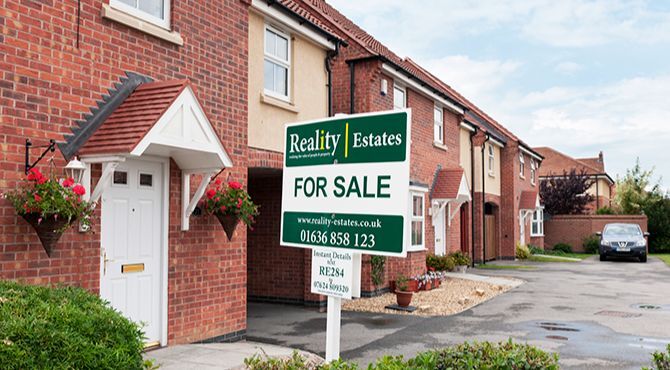UK housing market showing ’stoic resilience’
Average house prices across the UK increased by 6.7 per cent in the year to November 2016, according to new figures from the Office for National Statistics.

Early 2017 sees ‘brisk activity’
Jonathan Hopper, managing director of Garrington Property Finders, commented, “If ever there was an illustration of the property market’s stoic resilience, this is it. The ONS’ official data shows that, by November 2016, prices were growing at almost exactly the same rate as they were a year before.“After dusting itself off from the Brexit shock, the market recovered steadily at the tail end of 2016 as would-be buyers who had held off in the referendum’s immediate aftermath returned to the fold.“That initial procrastination has now been replaced by cautious optimism in many parts of the UK, and, on the front line, activity has been brisk during the early weeks of 2017."Related news:
- December produces surprise surge in house prices
- UK housebuilding proving 'key engine of growth'
- Halifax quality of life survey 2016: Winchester UK’s best place to live
Mr Hopper added, “There is a lot of competition for mid-priced properties, as there’s simply not enough stock to go around. Meanwhile, at the top end of the market – and in pockets of London – it's a different story. Buyers here now enjoy the upper hand, and are increasingly able to push for and get discounts.“Retailers’ strong sales in the run-up to Christmas suggest that there’s no shortage of consumer confidence. With interest rates still at record lows, many buyers are looking beyond the Brexit headlines at their own finances, and deciding that now is the time to buy before rising property prices erode their purchasing power.“With today’s jump in consumer inflation likely to nudge the Bank of England into increasing interest rates in coming months, there’s a growing sense that the cheap mortgages won’t last, and this is spurring many buyers into action.”
First-time buyer activity on the rise
Mark Dyason, director of Edinburgh Mortgage Advice, added, “The surge in buy-to-let remortgages is a result of landlords optimising their portfolios in advance of the new affordability regulations. Landlords were making hay while the sun still shone.“Since January 1, it has become a lot more difficult for landlords to finance their properties, especially at higher loan-to-values, and so a rush to remortgage in the final months of 2016 was inevitable.“The rise in first-time buyer activity is likely to increase as buy-to-let activity drops off throughout 2017. First-time buyers are starting to fill the hole left by landlords.“Remortgaging may have dipped compared to October, but a large amount of fixed-rate loans are coming to an end in the first few months of 2017, and we expect to see considerably more remortgage activity on the back of this.“What's now very clear is that the absolute best rates have gone. Rates are still incredibly competitive, yes, but if people want to secure the best of what's left, they need to act and soon.“While we are seeing more remortgaging, there could be a lot more and homeowner apathy could catch many out further down the line.“The rate rise in America and rising inflation in the UK (which hit 1.6 per cent on Tuesday) mean interbank rates are rising. This, in turn, means product rates are rising. People are unsure how far rates could rise, and so the preference is for slightly more expensive five-year fixes.”Demand ‘to dampen’
Andrew McPhillips, chief economist at Yorkshire Building Society, said that, although house price growth remained strong in 2016, he expected demand for both residential and buy-to-let properties to dampen in 2017. “We are therefore likely to see little movement in house prices over the coming year,” he said.“On the residential side, people are likely to have less spending power due to a combination of increasing inflation and stagnant wages which will make it even more difficult for people to save for a deposit. In terms of buy-to-let, tougher affordability requirements and a reduction in tax relief for mortgage interest payments could make letting properties less attractive to investors.”Ben Madden, managing director of London estate agents Thorgills, added, “Property prices in London remained buoyant at the end of 2016, rebuffing the doomsday predictions of many Brexit commentators. Many had assumed Londoners would batten down the hatches in the wake of the referendum vote and the stamp-duty hike, embodying the 'don't move, improve' ethos. As a result, the lack of fresh listings would see asking price growth constricted.“Instead, this data brings into sharp focus the growth proposition of certain areas of the capital, including Barking and Dagenham, which was among the top three local authorities in the whole of the UK for house price increases over the last year – seeing prices soar 17 per cent since November 2015.“Buyers have continued to hunt for more house for their money, moving away from the central nucleus to find better value in the capital's extremities.”For related news and features, visit our Residential Property section.
Access hundreds of global services and suppliers in our Online Directory
 Get access to our free Global Mobility Toolkit
Get access to our free Global Mobility Toolkit 
©2025 Re:locate magazine, published by Profile Locations, Spray Hill, Hastings Road, Lamberhurst, Kent TN3 8JB. All rights reserved. This publication (or any part thereof) may not be reproduced in any form without the prior written permission of Profile Locations. Profile Locations accepts no liability for the accuracy of the contents or any opinions expressed herein.









































